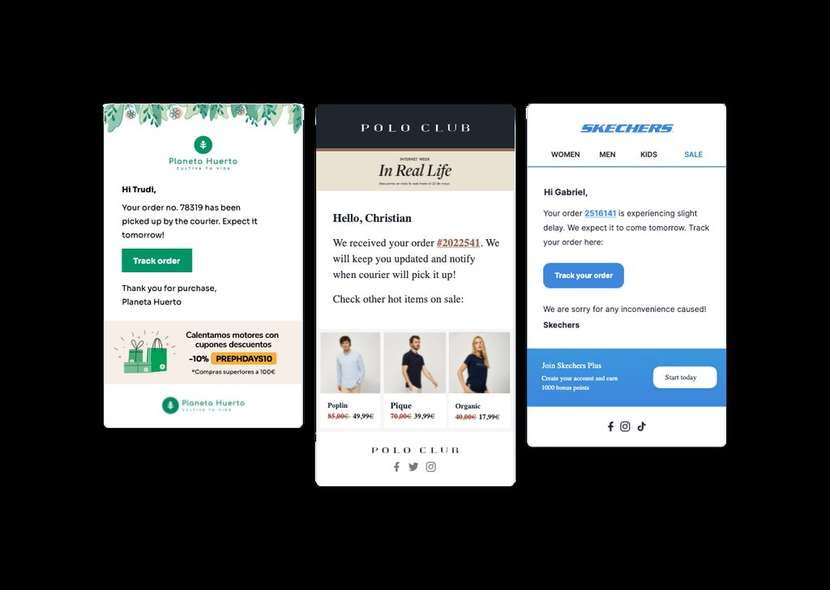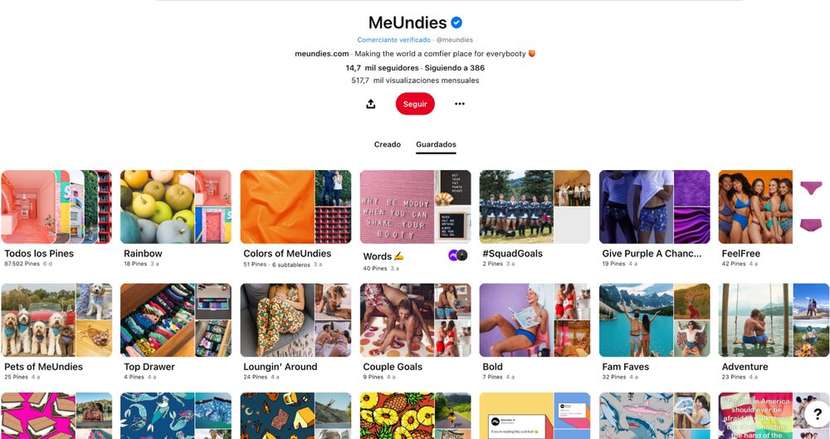Social commerce is a critical sales channel for businesses of all sizes. However, developing effective social commerce strategies can be challenging due to intense digital competition and evolving consumer trends.
In this guide, we will provide a comprehensive overview of social commerce, including its benefits, best practices, and common pitfalls. We will also analyze successful social commerce examples to identify key learnings.
What is social commerce?
Social commerce involves the translation of traditional sales strategies and channels into the realm of social networks or native applications. It allows users to purchase products without the need to visit a standard web store.
Benefits of social commerce
We have some great examples of ecommerce brands using social channels to boost sales, but before we get there, let's recap why you should invest in a social commerce strategy in the first place. Here is what it can do for you:
- Gain a deeper understanding of your target audience and tailor your offerings to their interests and needs more effectively.
- Reach customers worldwide, eliminating geographical limitations and expanding your market reach.
- Build stronger customer relationships by engaging with them directly and answering their questions.
- Simplify the purchase process and increase sales by allowing customers to buy your products without leaving their social media platforms.
- Increase brand awareness and visibility.
- Drive traffic to your website and other online channels.
- Generate leads and boost conversions.
- Improve customer satisfaction and loyalty.
Real-life examples of social commerce in action
1. Video testimonials by Barner

Positive reviews are social proof that validates a business's credibility and trustworthiness. They can be especially powerful in social commerce, where customers are often hesitant to buy from businesses they don't know well.
Product reviews with videos are particularly effective in driving sales and engagement. This is because videos allow customers to see the product in action and get a better understanding of its features and benefits.
One successful example of social commerce using video reviews is Barner. Barner creates short, engaging videos featuring real customers sharing their honest feedback about products. These videos are highly effective in persuading potential customers to buy, as they provide a genuine and relatable perspective on the product.
Here are some tips for using video reviews to boost your social commerce strategy:
- Make sure your videos are high-quality and engaging. Use good lighting and sound, and edit your videos to be concise and informative.
- Feature real customers in your videos. People are more likely to trust reviews from other people like them, so avoid using professional actors or models.
- Encourage your customers to share their honest feedback. Let them know that their reviews are valuable to you and other potential customers.
- Share your video reviews on social media and other online channels. This will help you reach a wider audience and boost your brand awareness.
By following these tips, you can use video reviews to build trust and credibility with your customers and drive sales and engagement for your social commerce business.
2. Custom order tracking notifications from Skechers

Order notifications are essential for social commerce. They keep customers informed about the status of their orders and help to build trust and loyalty.
Order notifications can also be used to generate new revenue. For example, businesses can include exclusive offers and promotions in their notifications. They can also use notifications to redirect customers to their product catalog or website, where they can browse and make additional purchases.
Skechers is a great example of a social commerce business that uses order notifications effectively. Skechers uses Outvio's customizable notification system to send customers notifications about their order status, promote items, add satisfaction surveys, and redirect traffic to their product catalog. Skechers also uses Outvio's analytics dashboard to monitor the performance of their notifications and identify areas for improvement.
Here are some tips for using order notifications to boost your social commerce strategy:
- Personalize your notifications. Use the customer's name and order information to make your notifications more relevant and engaging.
- Time your notifications carefully. Send notifications at times when your customers are most likely to be active on social media.
- Use clear and concise language. Make sure your notifications are easy to read and understand.
- Include a call to action. Tell your customers what you want them to do, whether it's to visit your website, browse your product catalog, or make a purchase.
- Track the performance of your notifications. Use analytics to identify which notifications are most effective and make adjustments accordingly.
3. MeUndie's Pinterest Board

MeUndies is a great example of how to use Pinterest for social commerce. Their boards are filled with creative and engaging content that promotes their products and adds value to their customers.
Here are a few tips that you can learn from MeUndies' Pinterest strategy:
- Use high-quality visuals. Pinterest is a visual platform, so it's important to use high-quality images and videos in your pins. Make sure your visuals are well-lit and well-composed, and that they accurately represent your products.
- Create informative and engaging content. Your pins should be more than just product photos. Write descriptive captions that tell your customers about your products and how they can benefit from them. You can also include links to your website and product pages so that customers can learn more and make purchases.
- Use relevant keywords. When you create pins, be sure to use relevant keywords so that people can find your content when they search for those keywords on Pinterest. You can use Pinterest's keyword research tool to find relevant keywords for your products and niche.
- Join relevant group boards. Group boards are a great way to get your pins seen by more people. When you join group boards, your pins will be shared with all of the members of the board. Make sure to join group boards that are relevant to your products and niche.
- Promote your Pinterest account. Let your customers know that you're on Pinterest and encourage them to follow you. You can promote your Pinterest account on your website, in your email signature, and on your social media channels.
4. Instagram and TikTok, San Saru

Instagram and TikTok are indeed two of the most engaging and conversion-driven social commerce platforms for the fashion industry. Their visual appeal, live streaming capabilities, and short video formats make them ideal for showcasing fashion products and connecting with potential customers.
SanSaru is a great example of a fashion brand that is using social media effectively. They have successfully connected with their audience by:
- Partnering with influencers. Influencers can help you reach a new audience and build trust with potential customers. When choosing influencers to partner with, make sure to select those who have a similar aesthetic and audience to your brand.
- Creating video guides. Video guides are a great way to teach potential customers about your products and how to use them. You can create video guides on how to style your products, choose the right size, or care for them properly.
- Running promotional campaigns. SanSaru's SanSaru Day is a great example of a successful promotional campaign. This campaign offered customers exclusive discounts and promotions on a specific day. SanSaru also used this campaign to generate excitement and engagement on social media.
Another good example of social commerce in the fashion industry is Revolve. Revolve is a popular online retailer that sells a variety of fashion brands. Revolve has a strong social media presence, and they use their social media accounts to promote their products, connect with customers, and drive sales.
Here are a few tips for using social media effectively to sell fashion products:
- Create high-quality visuals. Your social media posts should be visually appealing and eye-catching. Use high-quality images and videos that showcase your products in their best light.
- Write engaging captions. Your captions should tell a story and connect with your audience on an emotional level. Avoid writing generic or salesy captions.
- Use relevant hashtags. Hashtags are a great way to get your content seen by more people. When you use relevant hashtags, your content will show up in search results for those hashtags.
- Interact with your audience. Social media is a two-way street. Make sure to respond to comments and questions from your followers. You can also use social media to host contests and giveaways.
- Run social media ads. Social media ads can be a great way to reach a wider audience and promote your products. When creating social media ads, be sure to target your ads to the right people.
5. Distuptive Marketing, Taco Bell on X

Taco Bell is a master of social media commerce. They are known for their creative and engaging content, their ability to tap into current trends and memes, and their genuine interaction with their audience.
One of the things that Taco Bell does best is to create content that is relevant to their target demographic of young fast food enthusiasts. They use an informal and friendly language, and they often reference popular culture and memes. For example, when the popular "Distracted Boyfriend" meme was going around, Taco Bell created a version of the meme with a taco as the boyfriend and a quesadilla as the other woman. This meme was a huge hit with Taco Bell's audience, and it helped to promote their new quesadilla.
Another thing that Taco Bell does well is to interact with their audience in a genuine way. They respond to comments and questions on social media, and they often run contests and giveaways. This helps Taco Bell to build relationships with their customers and create a sense of community.
Overall, Taco Bell is a great example of how to use social media commerce effectively. They create creative and engaging content, they tap into current trends and memes, and they interact with their audience in a genuine way.
Here are a few tips for using social media commerce effectively, inspired by Taco Bell's success:
- Create relevant content. Your content should be relevant to your target demographic and their interests.
- Use an informal and friendly language. This will help you to connect with your audience on a more personal level.
- Tap into current trends and memes. This is a great way to stay relevant and get your content seen by more people. You can even create your own meme to boost engagement and make your brand stand out.
- Interact with your audience. Respond to comments and questions, and run contests and giveaways.
- Be creative and have fun! Social media is a great place to experiment and let your personality shine through.
What not to do: 20 bad examples and practices of social commerce
It's normalt make certain mistakes when only just getting started with social commerce strategies. We've gathered the most common ones here, so you can effectively avoid making them:
- Posting repetitive purchase links without context: Instead of posting direct purchase links, create engaging content that will encourage users to visit your website or online store. For example, you can share product images, review videos, or style tips. You can also use links to blog posts or other landing pages on your website.
- Sending unsolicited or overly intrusive direct messages: Only send direct messages to people who have given you their permission or who have shown interest in your brand. Make sure your direct messages are relevant and personalized.
- Leaving automated comments on others' posts with promotional content: Instead of leaving automated comments, leave helpful and relevant comments that contribute to the conversation. Avoid using promotional language in your comments.
- Buying fake followers or engagement to seem more influential: Buying fake followers or engagement will only damage your reputation in the long run. Focus on building a genuine following of people who are interested in your brand and what you have to offer.
- Ignoring user comments and questions on your posts: Always respond to user comments and questions in a timely and helpful manner. This shows that you value your customers and that you are interested in building relationships with them.
- Sharing low-quality content or unattractive product images: Make sure that all of your content is high quality and visually appealing. This includes your product images, blog posts, and social media graphics.
- Overusing sponsored posts without relevant organic content: Sponsored posts can be a great way to reach a new audience, but don't overuse them. Make sure to mix in a variety of organic content, such as product images, videos, and blog posts.
- Disregarding user privacy when collecting personal data: Be transparent with users about how you will use their personal data. Before collecting any personal data, make sure you obtain user consent.
- Using irrelevant or excessive hashtags in your posts: Hashtags can be a great way to get your posts discovered by new users, but don't overuse them or use irrelevant hashtags. Use relevant hashtags that are popular with your target audience.
- Not tailoring your strategy to each social media platform's nuances: Each social commerce platform has its own unique audience and culture. Tailor your strategy to each platform to get the best results.
- Failing to respond appropriately to criticism or negative comments: Don't ignore criticism or negative comments. Respond to them in a respectful and professional manner. Show that you are listening to your customers and that you are committed to improving their experience.
- Not providing clear information on prices, shipping policies, and returns: Make sure that your website or online store has clear and easy-to-find information on prices, shipping policies, and returns. This will help users make an informed decision about whether to purchase your products.
- Promoting products deceptively with exaggerated descriptions: Be honest and transparent when promoting your products. Don't make any promises that you can't keep.
- Lacking a coherent brand strategy or a clear brand voice: Develop a clear and consistent brand strategy and brand voice. This will help you to create content that is authentic and recognizable to your target audience.
- Neglecting to monitor analytics to assess the performance of your posts: Monitor your social media analytics to see what posts are performing well and what posts are not. This will help you to improve your social media strategy over time.
- Copying content from others: Don't copy content from other brands. Create your own original content that is relevant to your target audience.
- Using fake testimonials: Only use testimonials from real customers. Avoid using fake testimonials.
- Not obtaining user consent before tagging them: Before tagging a user in a post, make sure you obtain their consent.
- Overposting and overwhelming followers with spam: Don't overpost on social media. Post high-quality content that is relevant to your target audience in moderation.
- Failing to optimize the ordering experience: Make sure that your ordering experience is smooth and easy to follow. Avoid any hidden fees or unexpected costs.
- Not being patient. Social commerce takes time and effort to build: Don't expect to see results overnight. It takes time and effort to build a successful social commerce business.
- Not tracking your results: Track your social commerce results to see what is working and what is not. This will help you to improve your strategy over time.
- And the biggest mistake of them all: not tapping into social commerce at all!: Social commerce is a growing trend that businesses of all sizes can benefit from. If you're not already using social commerce to sell your products, start today!
Most effective social commerce platforms
When it comes to implementing social commerce strategies, it's essential to choose the right social networks for your target audience. Here's a rundown of some of the most effective ones and their key features:
- Facebook: offers features like storefronts and integrated shops, allowing you to showcase and sell products directly from your brand's page
- Instagram: enables product tagging in posts and direct links to your online store through Instagram Shopping. It's a fantastic social commerce platform for visual product promotion
- Pinterest: ideal for brands in fashion, beauty, and home decor, Pinterest allows you to share product pins linked to your online store. It's a visual paradise for potential customers
- X: X doesn't have specific social commerce features, you can leverage third-party apps like Chirpify to include "Buy" buttons in your tweets. It's a way to add a shopping element to your tweets
- YouTube: though lacking direct social commerce features, YouTube can be effective in showcasing products within a context. Creative content can direct users to your online store

Tips for your social commerce strategy
So far we have seen some good examples and a list of not-to-do’s, let’s now take a look at a few examples of practices that can be super handy for boosting your eCommerce sales in social media:
Choose the right social platforms
Dig deep and figure out which social media platforms are the best fit for your eCommerce business. It could be the one where most of your audience hangs out, where your competitors are, or where you see the most potential for growth.
Polish and maintain your profile
Your business profile should radiate trustworthiness. Pay close attention to the details, use high-quality images, include contact emails, physical addresses, and more. Always go for transparency and authenticity.
Nurture Your Databases
A common blunder is working with outdated databases. When that happens, some of your messages end up reaching inactive or disinterested customers, which hurts your profit margins and raises costs.
Offer Multiple Shipping Options
If you want to ramp up your sales, consider centralizing multiple carriers into a TMS system to provide buyers with various delivery choices. The more shipping options you have, the better your conversion rate at checkout.
Engage with user comments
One of the cool things about social media marketing is the direct interaction with customers. Respond to all comments, whether they're good or not-so-great, to appear as a brand connected to its audience. Pay attention to tone and adapt to your specific audience.
Make the most of tags and stickers
Social media is a treasure trove of design possibilities. Get creative by adding fun tags or stickers to your posts, but don't lose sight of your overall strategy or brand tone.
Adapt the shopping experience
This is where many businesses stumble. Selling on social media requires tweaking your business structure for the mobile commerce environment. Additionally, ensure that you provide quality tracking and customer service, especially for your predominantly younger audience.
Leverage social proof
Make sure you gather a significant number of positive reviews before launching any campaign. Struggling to get those positive reviews? Outvio's Review Booster feature automatically contacts your happiest customers and encourages them to leave a review.
Streamline the return process
A significant chunk of traffic from social media often abandons their purchase due to unfavourable return policies. We recommend designing a convenient and flexible return policy. For more advanced management, consider using an automated returns portal.
Keep customers informed
The array of channels and platforms where a user can shop calls for multi-channel communication. Send order notifications through major channels like WhatsApp, SMS, email, etc., and ensure all your customers receive them.
How to integrate social commerce into an online store?
The most crucial aspect, aside from the social media strategy itself, is ensuring that the purchasing and ordering process meets the necessary standards. It's of no use to attract a lot of traffic if your logistical structure doesn't measure up. In this regard, one of the most useful tools for your eCommerce is Outvio, so don’t forget to check us out.
Once you have analysed the best examples and practices of social commerce and which are the best business platforms, you just have to get on with it!




